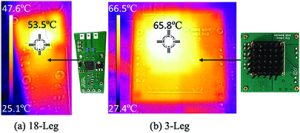Variable-Pole Induction Machines Drives for Electric Vehicles
Elie Libbos with advisor A. Banerjee
Electric vehicle (EV) drivetrains require power-dense and efficient motors, operating over a wide speed range. The induction machine (IM) offers a cost-effective and reliable alternative to permanent magnet-based solutions. Our proposed solution is to co-design a toroidally-wound IM and an 18-leg drive to electronically vary the IM pole count to six-, four- and two-pole. Figure 1 shows that the 18-leg system improves torque at the maximum speed by a factor of 2.4X compared to conventional fixed-pole three-leg drive while reducing fundamental frequency requirement from 1000 to 413 Hz. Our proposed power electronics and machine co-design framework shows system-level efficiency improvement especially at partial torque and high-speed, machine volume and loss reduction, 62% dc link capacitance reduction and improvement in thermal performance compared to a conventional three-leg fixed-pole drive.
Figure 2-a shows our experimental setup. An 18-leg GaN-based inverter is used to drive a 36-slot toroidally wound IM with access to each of its individual slots. This setup allows us to reconfigure the IM to various pole counts (2-, 4-, 6-poles). A Zedboard field programmable gate array is used to control the converter and create a user-friendly interface. Figure 2-b shows that the 18-leg drive simplifies thermal management by eliminating the heatsink and still operates at a lower temperature compared to three-leg drive with the same rating driving the same machine. These thermal improvements are mainly achieved because of the higher efficiency of the 18-leg converter and better loss sharing among more phases

Fig. 1. A variable pole-count induction machine has 2.4X more torque capability compared to its fixed-pole counterpart at the maximum speed while reducing fundamental frequency from 1 kHz to 413 Hz.

Fig. 2. (a) Experimental setup with the 36-slot toroidally wound IM driven by two 9-phase GaN-based inverter modules. Part (b) shows that the 18-leg converter
simplifies thermal management by eliminating heat sink and still operates at lower temperature compared to a conventional three-leg converter with same rating.

